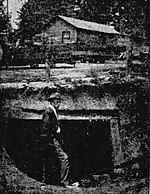The Coal Glen mine disaster was a series of explosions that occurred on May 27, 1925, at a coal mine in Coal Glen, Chatham County, North Carolina, United States. At least 53 miners died in the explosions, making it the deadliest industrial disaster in North Carolina's history. The incident also partly contributed to North Carolina's adoption of a workers' compensation law several years later.
The Coal Glen mine was opened by the Carolina Coal Company in North Carolina's Deep River Coal Field in about 1921. Though equipped with a ventilation system, signs of firedamp buildup were observed the day before the disaster. On the morning of May 27, 1925, three explosions occurred in the mine. The first explosion killed all underground workers and their team of mules, while the subsequent blasts injured the mine superintendent and temporarily blocked the shaft with debris. Recovery efforts were led by State Adjutant-General John Van Bokkelen Metts and a group of engineers, with additional support offered by the United States Bureau of Mines and civic groups from the nearby city of Sanford. Local authorities confirmed at least 53 men were killed, but the actual death toll may be higher.
State and federal investigators later concluded that the first explosion was caused by an improperly set blasting charge which blew out a dust cloud that subsequently ignited. The disaster left 38 women widowed and 79 children fatherless. The mine was permanently closed in 1953 and later flooded. A state historical marker commemorating the event was dedicated in 2017.



